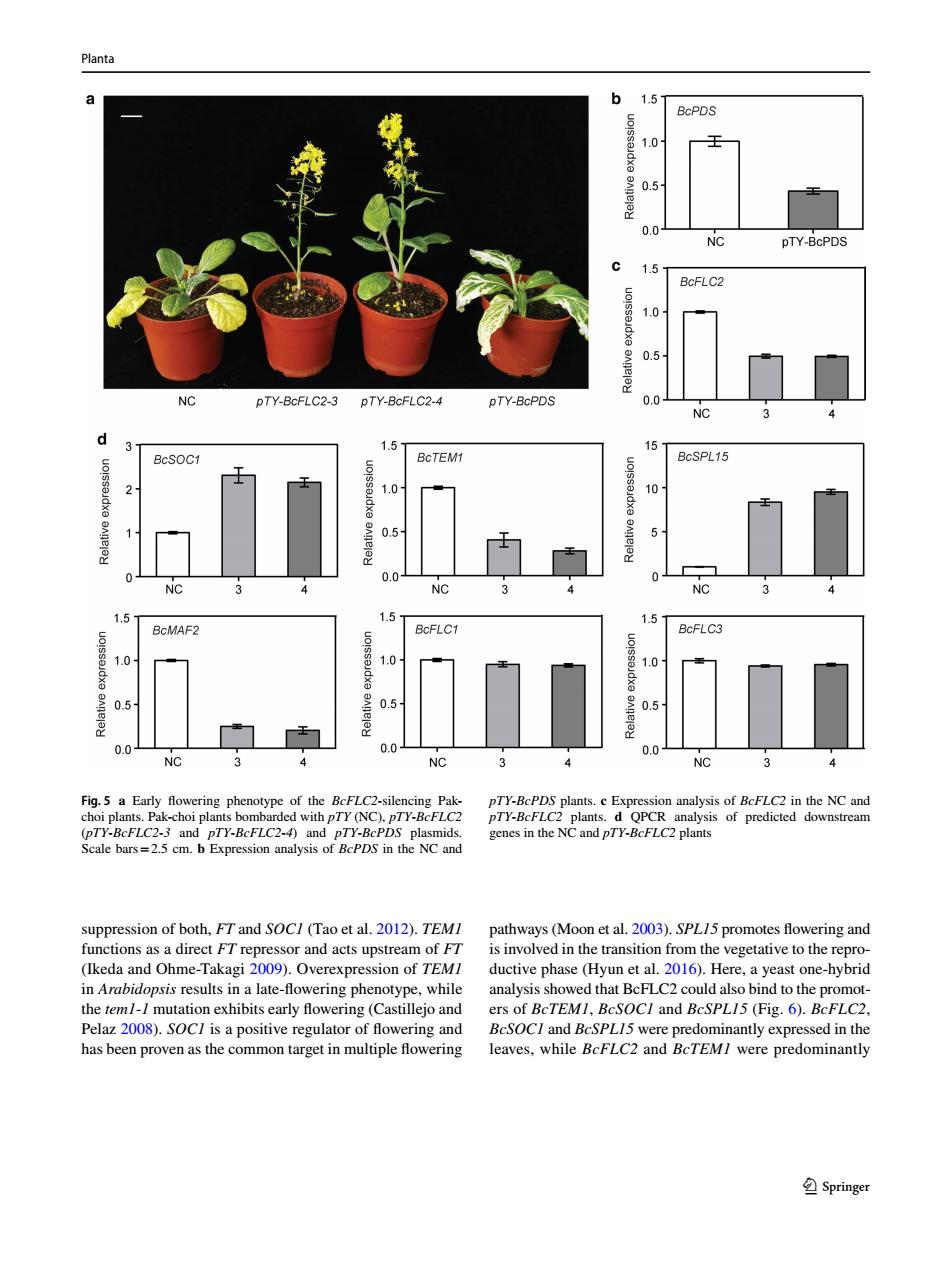正在加载图片...

Planta b 1.51 BcPDS 1.0 0.5 0.0 NC pTY-BcPDS 1.5 BcFLC2 1.0 0.5 NC pTY-BcFLC2-3 pTY-BcFLC2-4 pTY-BCPDS 0.0 NC d 1.5 15 BcSOC1 BcTEM1 BcSPL15 1.0 10 0.5 5 0.0 NC NC NC 1.5 1.5 1.5 BcMAF2 BcFLC1 BcFLC3 1.0 1.0 1.0 0.5 0.5 0.5 0.0 0.0 0.0 NC NC 3 NC 3 Fig.5 a Early flowering phenotype of the BcFLC2-silencing Pak- pTY-BcPDS plants.c Expression analysis of BcFLC2 in the NC and choi plants.Pak-choi plants bombarded with pTY (NC).pTY-BcFLC2 pTY-BcFLC2 plants.d QPCR analysis of predicted downstream (pTY-BcFLC2-3 and pTY-BcFLC2-4)and pTY-BcPDS plasmids. genes in the NC and pTY-BcFLC2 plants Scale bars=2.5 cm.b Expression analysis of BcPDS in the NC and suppression of both,FT and SOCI (Tao et al.2012).TEMI pathways(Moon et al.2003).SPL/5 promotes flowering and functions as a direct FT repressor and acts upstream of FT is involved in the transition from the vegetative to the repro- (Ikeda and Ohme-Takagi 2009).Overexpression of TEM/ ductive phase (Hyun et al.2016).Here,a yeast one-hybrid in Arabidopsis results in a late-flowering phenotype,while analysis showed that BcFLC2 could also bind to the promot- the tem/-I mutation exhibits early flowering(Castillejo and ers of BcTEMI,BcSOCI and BcSPL15(Fig.6).BcFLC2, Pelaz 2008).SOCI is a positive regulator of flowering and BcSOCI and BcSPLI5 were predominantly expressed in the has been proven as the common target in multiple flowering leaves,while BcFLC2 and BcTEMI were predominantly SpringerPlanta 1 3 suppression of both, FT and SOC1 (Tao et al. 2012). TEM1 functions as a direct FT repressor and acts upstream of FT (Ikeda and Ohme-Takagi 2009). Overexpression of TEM1 in Arabidopsis results in a late-fowering phenotype, while the tem1-1 mutation exhibits early fowering (Castillejo and Pelaz 2008). SOC1 is a positive regulator of fowering and has been proven as the common target in multiple fowering pathways (Moon et al. 2003). SPL15 promotes fowering and is involved in the transition from the vegetative to the reproductive phase (Hyun et al. 2016). Here, a yeast one-hybrid analysis showed that BcFLC2 could also bind to the promoters of BcTEM1, BcSOC1 and BcSPL15 (Fig. 6). BcFLC2, BcSOC1 and BcSPL15 were predominantly expressed in the leaves, while BcFLC2 and BcTEM1 were predominantly Fig. 5 a Early fowering phenotype of the BcFLC2-silencing Pakchoi plants. Pak-choi plants bombarded with pTY (NC), pTY-BcFLC2 (pTY-BcFLC2-3 and pTY-BcFLC2-4) and pTY-BcPDS plasmids. Scale bars=2.5 cm. b Expression analysis of BcPDS in the NC and pTY-BcPDS plants. c Expression analysis of BcFLC2 in the NC and pTY-BcFLC2 plants. d QPCR analysis of predicted downstream genes in the NC and pTY-BcFLC2 plants